LinkedIn for Real Estate Agents: How to Get Leads & Referrals
SOURCE: fitsmallbusiness.com by Kiah Treece on December 3, 2018
To get a better return on investment (ROI) from your real estate marketing efforts, focus your resources on a LinkedIn networking strategy to generate leads and referrals. Optimize your LinkedIn profile by including professional photos, summarizing your experience, and providing valuable content. Then, reach out to existing contacts and build your network through mutual connections.
Maximize lead generation by using LinkedIn to capture lead contact information. BoldLeads offers more than 40 different landing pages you can link to from your LinkedIn profile and articles. The platform can also capture info from a visitor’s media profile, so you’ll still get a partial lead if prospects only enter an address.
Visit BoldLeads
How to Set Up Your LinkedIn Real Estate Profile to Get More Leads in 8 Steps
When looking to get real estate leads on LinkedIn, start with an optimized LinkedIn profile as well as a connected real estate landing page. Choose a professional headshot, summarize your strengths and build your recommendations and endorsements. If you don’t already have a LinkedIn account, click here to set one up.
Specific steps to set up your LinkedIn real estate profile include:
1. Upload a Professional Headshot
If you’re trying to get leads and referrals through LinkedIn, first focus on your profile. Your headshot is likely the first thing your leads see on your profile page, in search results or when you invite them to connect, so a great headshot is crucial.
Use a headshot that shows leads that you’re confident, competent and likable enough to connect with and eventually hire. The image should also be high-resolution and professional — not a grainy image, a photo obviously taken at a bar or a picture that doesn’t reflect who you are as a real estate agent.
After you upload your headshot to LinkedIn, make sure to preview your profile to make sure it’s cropped properly. For more insider tips on taking the perfect headshot for LinkedIn, check out our in-depth guide to Realtor headshots.
One of the best ways to make sure your headshot is LinkedIn worthy is to use Photofeeler. Photofeeler puts your headshot in front of thousands of people who anonymously rank it for competence, likability , nd influence. You can upload a few different versions of your headshot and use the one that users rank the best on LinkedIn.
Visit Photofeeler
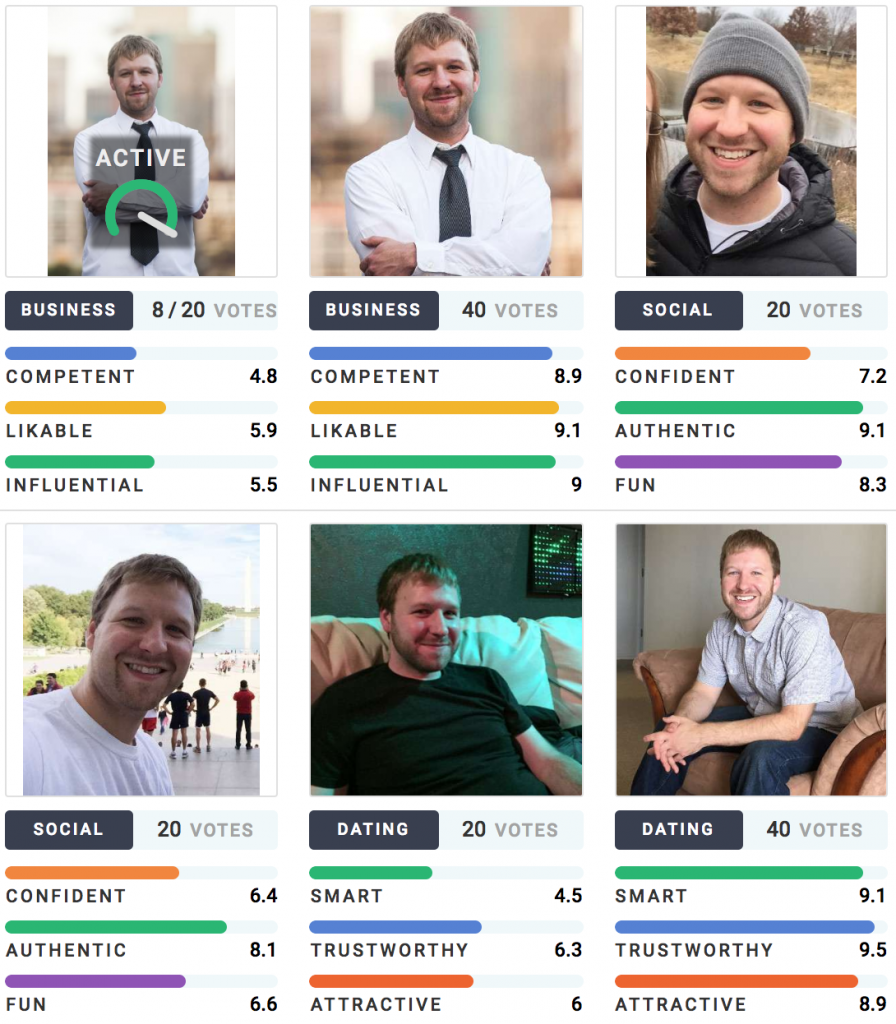
Screenshot of Photofeeler.
2. Choose a Background Photo That Works With Your Headshot
Once you upload a professional headshot on LinkedIn, choose a background that complements it. You don’t have to choose a real estate-related background photo like Phil Greely’s below, but it might help share information with your connections and attract potential leads. Either way, choose an image that’s attractive, professional, and doesn’t look too busy.
If you don’t have a great picture ready to go, you can either download a background photo from a site like Linkedinbackground.com or download a picture from a free stock image site like Unsplash. Unsplash generally has much higher quality images, but you may have to resize or crop the photo to fit your background. If you don’t have photo editing software or Adobe PDF, use a site like Canva or hire a freelancer on Fiverr.
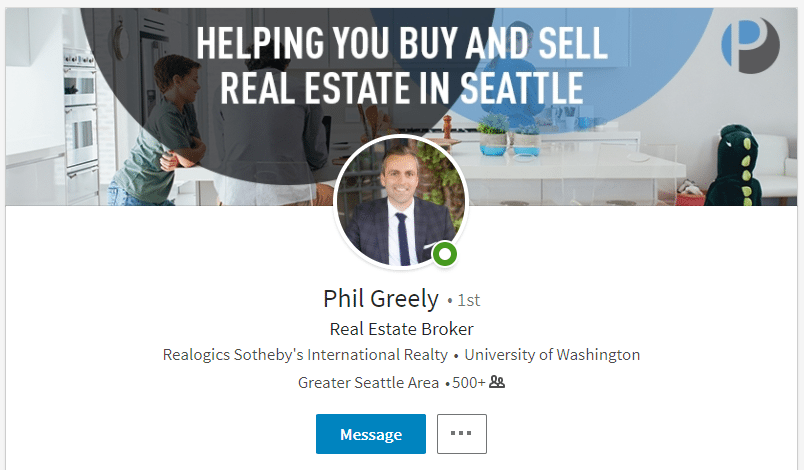
Screenshot of Seattle Broker Phil Greely’s LinkedIn profile.
3. Use Your Headline to Show off Your Real Estate Mojo
After your headshot, your headline is the second-most important element of your LinkedIn profile. Your headline on LinkedIn is a short, 100-character description of your current role. Generally speaking, your headline should be your job title, but you can and should get creative with it to attract more leads.
For example, if you work in Malibu selling waterfront homes and love surfing, make a headline like “Malibu Area Realtor Since 2006 | Surfer since 1986.” Alternatively, mention accomplishments (“Voted the Best Malibu Realtor by Malibu Magazine”) or highlight your focus area (“Malibu Waterfront Homes Expert at Keller Williams”).
Not only does your headline work for you by showing off your skills, but you can also change it anytime to reflect your real estate business better. Just be sure to keep National Association of REALTORS (NAR) and state licensing disclosure regulations in mind when writing your headline or adding your job title to LinkedIn. If you’re not sure what your official title is, ask your managing broker or reach out to your Realtor association for advice.
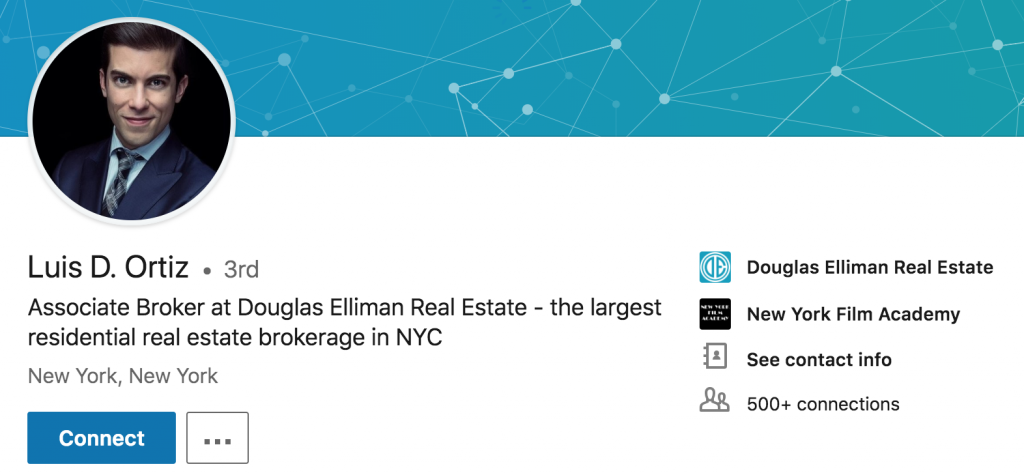
Screenshot of Luis Ortiz’s LinkedIn headline.
4. Write a Compelling Summary & Choose a URL
After you add a professional headshot, background and headline to your profile, write a compelling summary and choose a URL. For your profile summary, draft a concise description of your approach to real estate, details about your brokerage or other relevant details. Your goal is to get leads to call or connect with you, so highlighting career achievements briefly can also help.
LinkedIn also allows you to create a custom URL for your profile page, which makes your profile easier to find and easier for leads to remember. Using your name or your real estate company name is an obvious choice. However, you can always get creative if your name or company name is very common. Below are some good examples of LinkedIn real estate profile examples.
Example 1 — Ryan Serhant, The Serhant Team
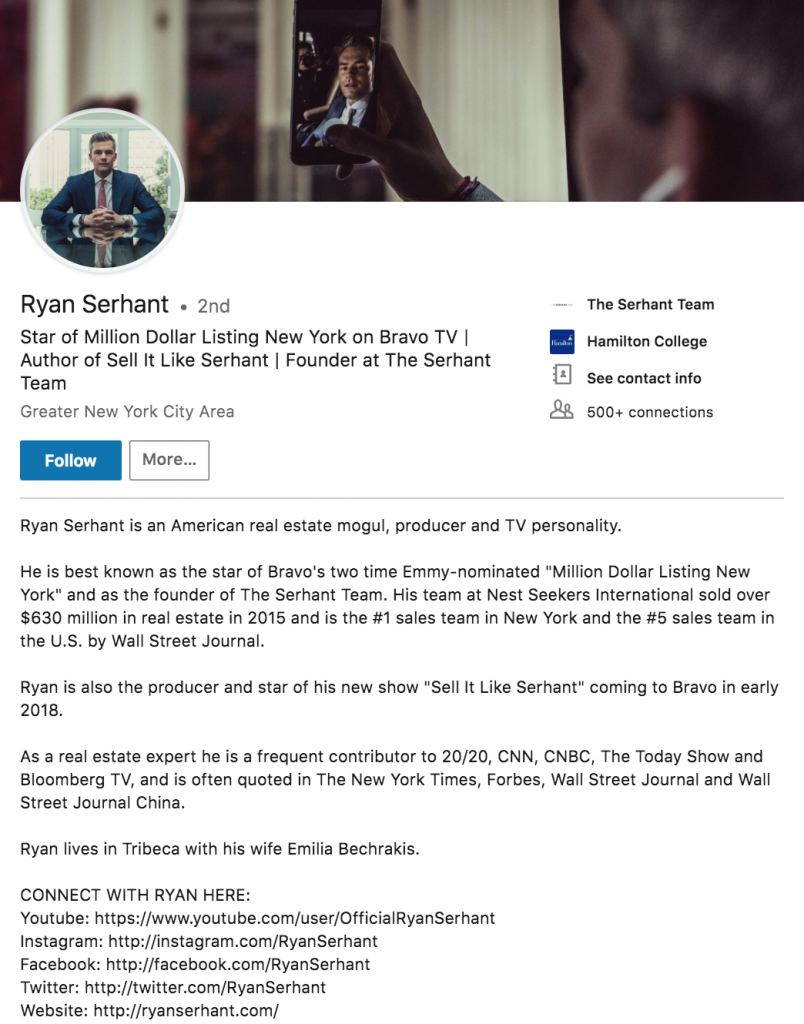
Screenshot of Ryan Serhant’s LinkedIn summary.
Example 2 — Michelle Kantzler, Dale Sorensen Real Estate, Inc.
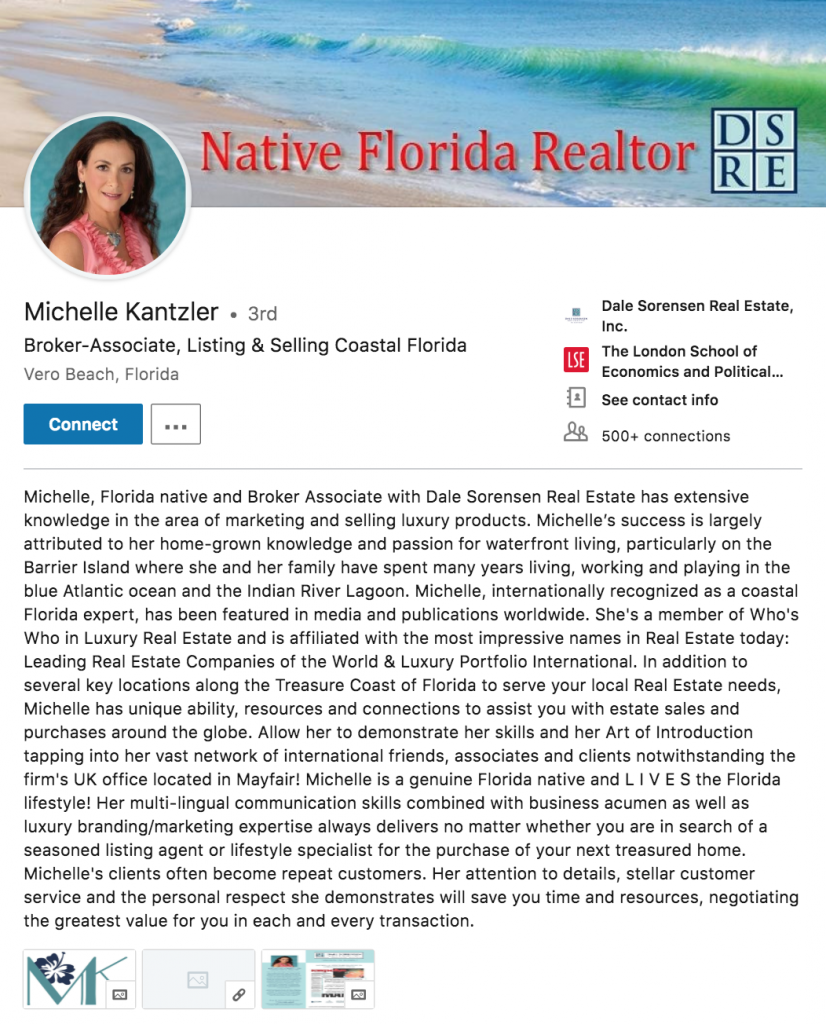
Screenshot of Michelle Kantzler’s LinkedIn summary.
Example 3 — Stephanie Sainz, Bald Head Realty

Screenshot of Stephanie Sainz’s LinkedIn summary.
5. Fill Out Your Work Experience, Skills, Education & Accomplishments
When leads are truly vetting you, they dig deep into your profile and review your work experience, skills, education and accomplishments. To provide a complete picture of your professional background and skills, complete those sections of your LinkedIn profile in detail. Try to focus on how you helped your clients rather than a rote resume-like description of your job duties.
While being creative with your job descriptions and summary can be a huge help on LinkedIn, remember to keep NAR and local regulations on advertising in mind. For example, in New York state, the only official job title agents can use is “Licensed Real Estate Salesperson.” There are also restrictions on team and brokerage names.
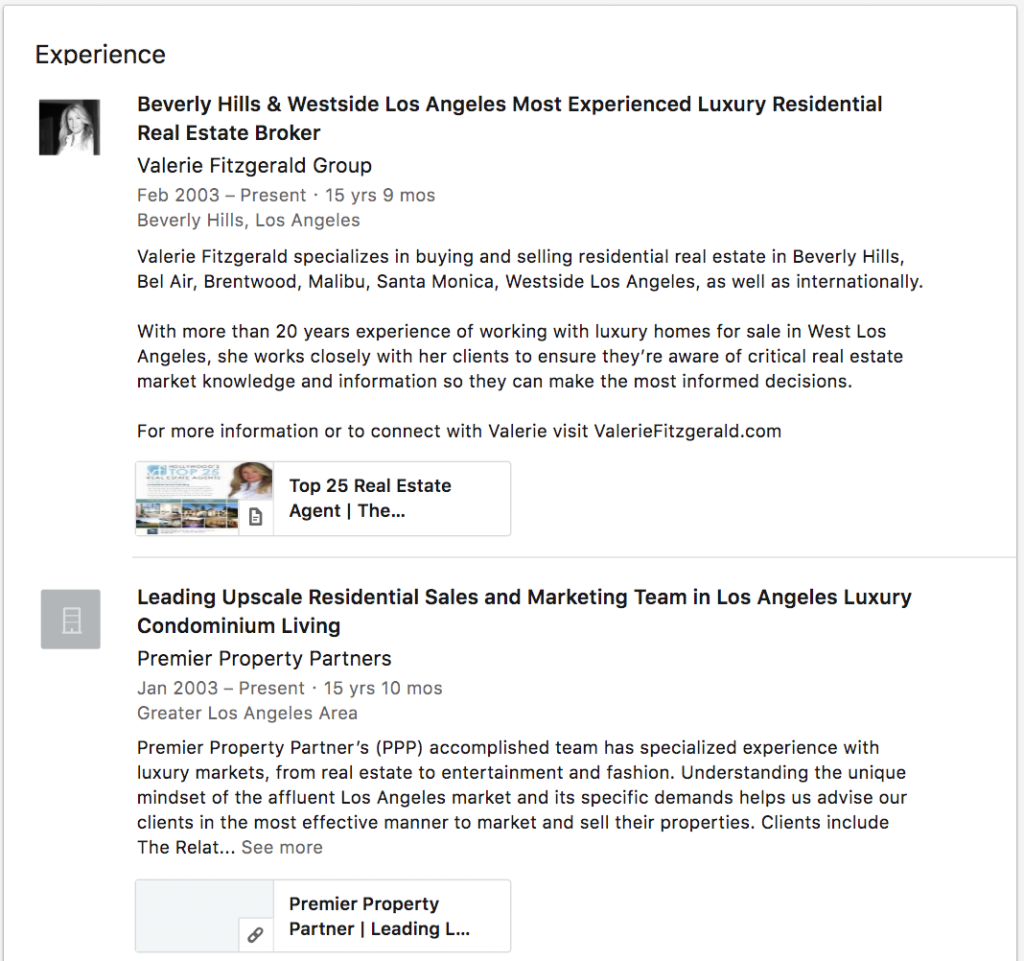
Screenshot of broker Valerie Fitzgerald’s experience.
6. Reach Out for Recommendations & Skill Endorsements
LinkedIn provides a recommendations section that allows former clients or colleagues to write up testimonials about your services. To strengthen your profile, reach out to colleagues and former clients after connecting to see if you can get recommendations from them. Recommendations like these show potential clients that they can trust you and make prospects more likely to reach out for your services.
LinkedIn also lets your connections “endorse” the skills you have on your profile or suggest other skills. Endorsements are most valuable when they’re relevant to your area of specialty and come from someone who excels in the same field. To build your LinkedIn endorsements page, consider leaving positive feedback for your colleagues, past clients and other connections to encourage reciprocal endorsements.

Screenshot of broker Valerie Fitzgerald’s endorsements and recommendations.
7. Create Eye-catching & Informative Content
Another great way to build your network and convert connections to clients is to produce and publish useful real estate content on LinkedIn. You can write about market advice, notable recent closings, neighborhood news or anything else that you think will educate or entertain your potential leads. You can even post videos and infographics to your LinkedIn page.
Not only is LinkedIn content a great way to engage current and potential clients, but you can also use the same content to boost the search engine optimization (SEO) value of your personal website or blog. What’s more, you can use the content to link to your internet data exchange (IDX) website and social media pages to expand your reach online.
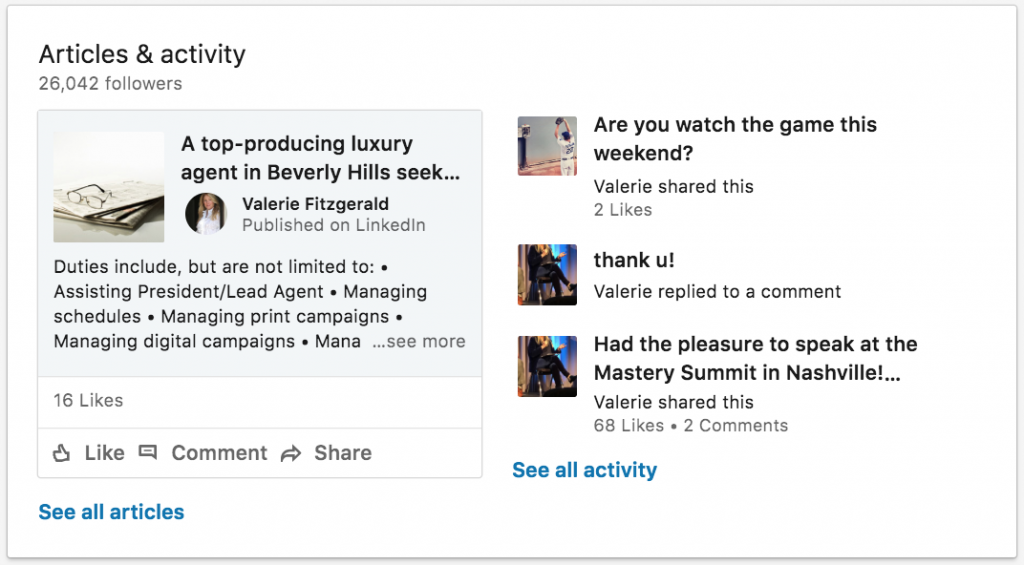
Screenshot of broker Valerie Fitzgerald’s articles and activity.
8. Create a Home Valuation Landing Page
One of the best ways to add credibility to your LinkedIn profile and capture leads directly from LinkedIn is with a home evaluation landing page. After you create your LinkedIn real estate profile, create a professional landing page that solicits lead contact information before providing access to home valuation data. This will allow you to direct LinkedIn leads directly to a lead capture form.
BoldLeads offers more than 40 different landing pages you can place on your website and link to from your LinkedIn profile and posts. BoldLeads also captures info from a visitor’s media profile so you’ll still get a partial lead if prospects only enter an address. Click here to build a home valuation landing page.
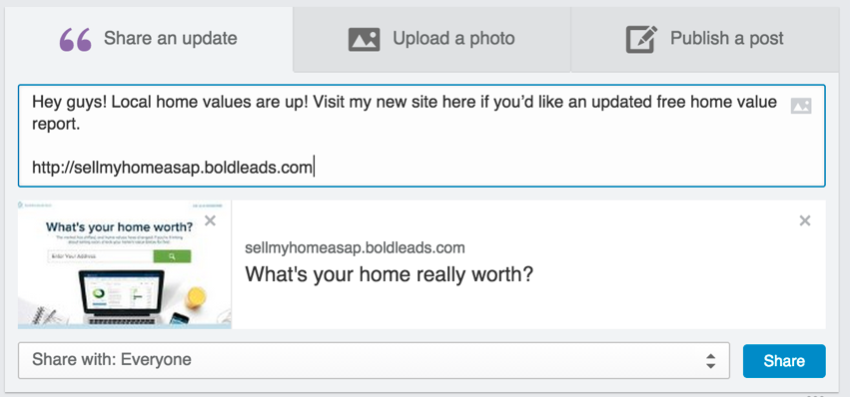
Screenshot showing how to add a link to your BoldLeads home evaluation page.
How to Build a Network on LinkedIn for Real Estate Leads in 5 Steps
Network building on LinkedIn for realtors is the same as it is for any other industry. Once you optimize your LinkedIn profile, start building your network through existing contact lists, professional groups and your website.
In addition to connecting with email contacts, expand your industry and market knowledge by joining relevant groups and reaching out to recommended contacts. Then, ensure your website visitors can find you by sharing a profile badge.
The five steps you can use to build your LinkedIn real estate network include:
1. Allow LinkedIn to Connect With Your Email Contacts Automatically
When you first join LinkedIn and build out your profile, you’ll be prompted to allow LinkedIn access to your contact list to invite them to connect with you on LinkedIn. This may not be the most personal way to build your network, but it’s quick, efficient and automatic. Plus, plugging into your existing contacts enables you to reach out to colleagues, former and current clients in your market and more.
Once a contact accepts your invitation to connect, send her a quick thank you message or re-introduce yourself if you haven’t spoken in a while. You can also use this as an opportunity to offer your services or advice with no strings attached. If you already have an established relationship with a contact, then consider asking them to endorse you for one of your skills or, better yet, leave a recommendation.
2. Use Clearbit Connect to See LinkedIn Profiles Directly in Gmail
If you’re using Gmail as your email client, there’s an excellent plug-in called Clearbit Connect that pulls social media information including LinkedIn profiles, for anyone that you exchange emails with. This allows you to connect with contacts on LinkedIn quickly and easily or check out their other social media profiles. Similarly, Rapportive shows you whether you’re already connected with your contacts and gives you a connect button if you’re not.
3. Join Local LinkedIn Real Estate or Professional Groups
LinkedIn also offers local real estate and professional groups that are a great resource for networking events, industry insight and more. The type and number of groups that LinkedIn lets you join are based on your qualifications and network, so it pays to build your connections. Keep in mind, however, that many LinkedIn groups are closed, meaning you’ll have to request to join.
You can search for groups by name, industry or by searching local keywords from your LinkedIn homepage. For example, try top-level searches for your city and see what kinds of groups show up. Once you join a group, you may also be able to connect with people outside your network without using InMail credits. Make the most out of LinkedIn by strategically choosing groups that are well-suited to your industry and market.
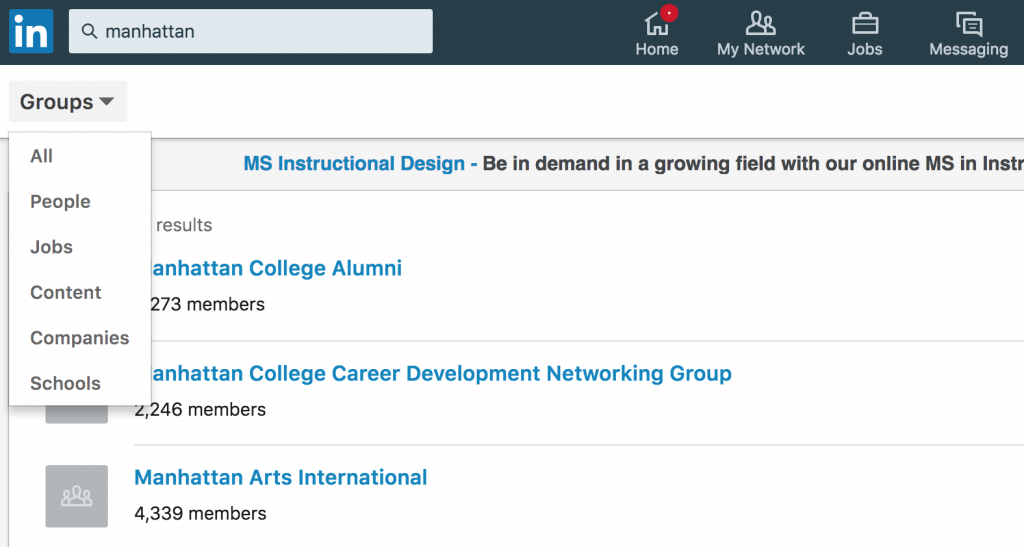
Screenshot of local LinkedIn groups.
4. Use LinkedIn’s ‘Recommended for You’ Feature
LinkedIn’s recommended connections feature allows you to connect with people who may already be in your professional network easily. The platform makes these suggestions based on your current first-degree connections and lets you expand your reach to people already in your market. Expand your reach by clicking “My Network” and reviewing the “Recommended for you” section.

Screenshot of LinkedIn’s “Recommended for you” feature.
5. Add a Public Profile Badge to Your Website & Email Signature
Another great way to build up your network is to create LinkedIn public profile badges that you can add to your website, email signature and other documents. These personalized badges share pertinent information with potential clients and give prospects a way to link directly to your LinkedIn profile. LinkedIn automatically creates several badge options and provides script you can copy and paste anywhere on your website.
To set up a public profile badge, take the following steps:
- Click on “View Profile” under your picture on the top right of the LinkedIn homepage
- Select “Update Your Public Profile Settings”
- Click on “Your Public Profile Badge” and follow the instructions to build a profile badge for your website
- Finally, copy the code for your badge and paste it onto your website
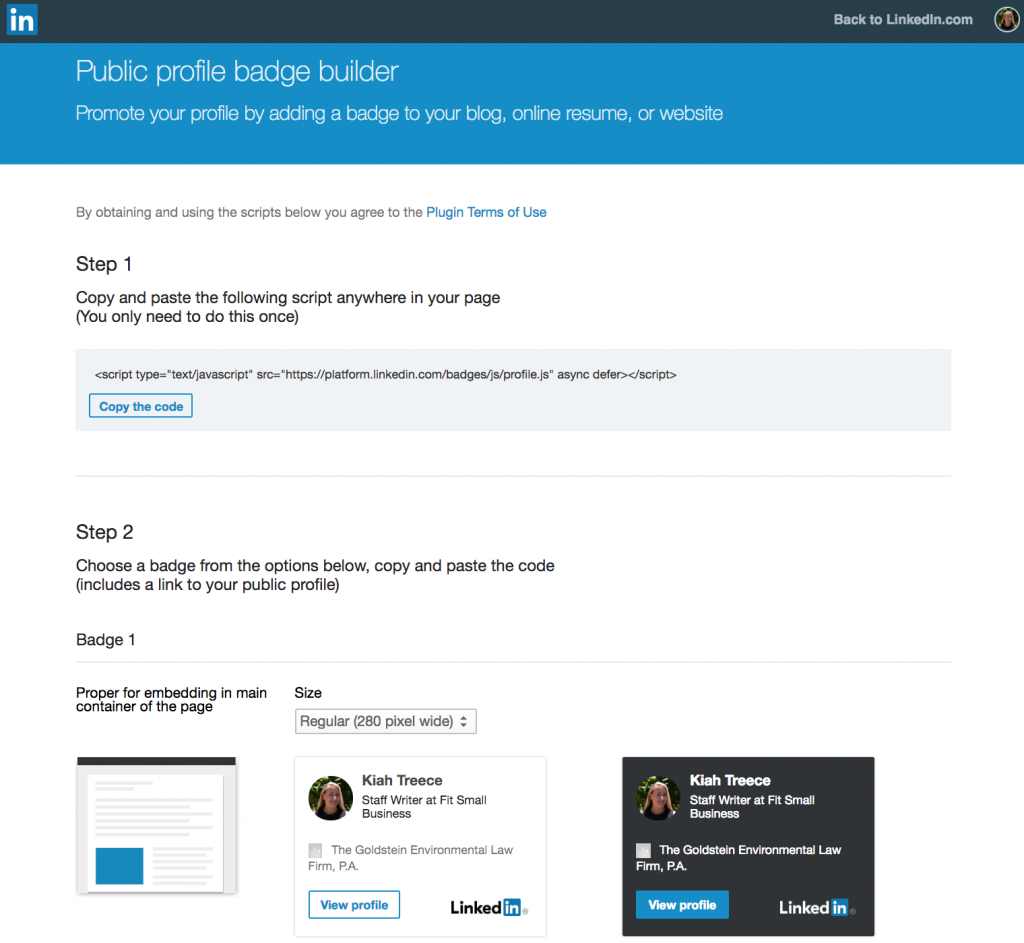
Screenshot of LinkedIn profile badge builder.
Basic LinkedIn Networking for Realtors: Degrees of Connection
When using LinkedIn effectively to increase real estate leads, you need to understand the basic principles behind networking. People in your network are called first-degree connections, while others are labeled second degree or third degree depending on their relationships. Build your network by adding second-degree connections and using the InMail feature to expand your reach.
Unlike Facebook or Twitter where you can add or follow almost anyone, LinkedIn restricts your networking options dramatically based on your degree of connection. Your goal as a Realtor on LinkedIn is to get as many local connections as possible, as quickly as possible, so understanding how these connections work on LinkedIn is crucial.
The three degrees of LinkedIn connections are:
1. First-degree Connections
First-degree connections are people who are already in your network. For example, if you have a brand-new LinkedIn account and a coworker invites you to connect with them, they will become a first-degree connection. Likewise, if they accept your offer to connect, they will become a first-degree connection.
With some limited exceptions, first and second-degree connections are the only people you can directly reach out to on LinkedIn. In some cases, you won’t even be able to see any details about people who are not first- or second-degree connections.
2. Second-degree Connections
Second-degree connections are the people who belong to the networks of your first-degree connections. LinkedIn allows you to invite these people to join your own network easily by clicking on the “connect” button that shows up on their profile or in a list of suggested connections. Build your network by taking advantage of your colleagues’ and clients’ existing connections.
For example, if your co-worker has a mortgage broker you know in their network, you can click on connect in order to invite them to join your network. If they accept, everyone in their network is now your second-degree connection.
3. Third-degree Connections
Third-degree connections are those people who are connected with your second-degree connections. In most cases, you can’t directly invite third-degree connections to connect with you. Instead, you have to send them “InMail,” which is a direct message through LinkedIn’s premium option. Accounts start at $29.99 per month and enable you to send three InMail messages monthly.
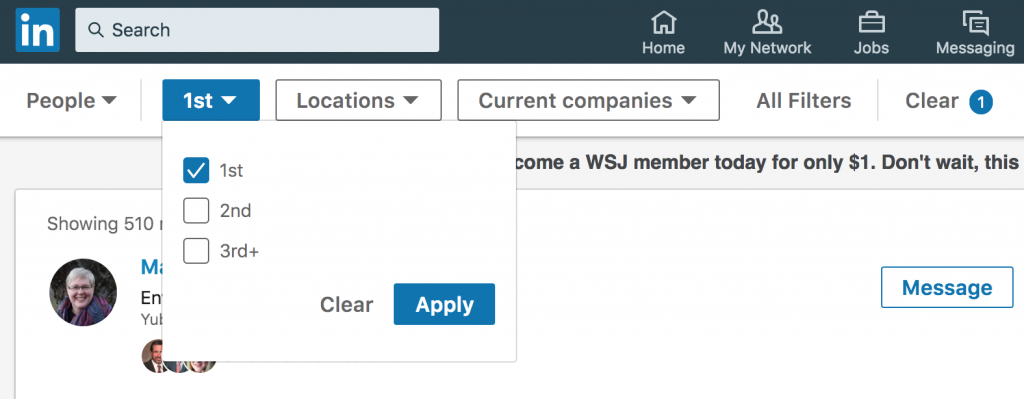
Screenshot of LinkedIn connection types
Expert Tip: Invite Third-degree Connections to Connect for Free
The easiest way to add a third degree or higher connection to your network is to exchange an email with them. That means every single person in your email contacts list can be invited to join your LinkedIn network for free. You can also join LinkedIn groups which will sometimes allow you to connect to third-degree and higher connections.
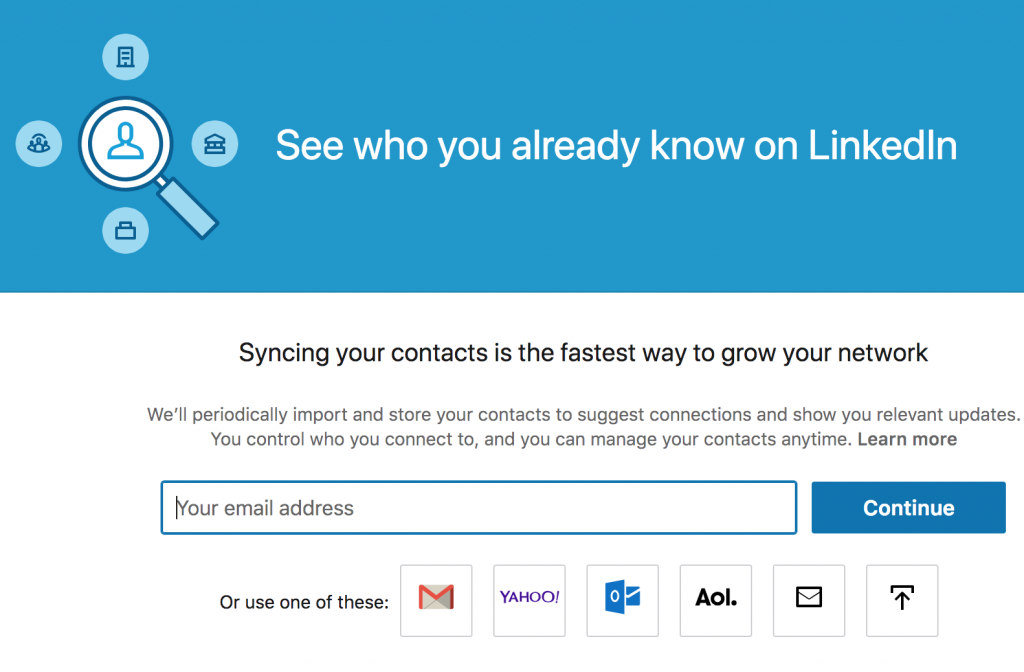
Screenshot of contact linking for LinkedIn.
Reasons Why LinkedIn is Great for Real Estate Leads
LinkedIn gets around 250 million unique visitors every month — a far cry from Facebook’s more than 2 billion active monthly users. For reasons like this, most real estate agents find it difficult to justify spending any of their social media outreach resources on LinkedIn. However, this is a huge mistake because it prevents agents from taking advantage of LinkedIn’s huge potential for lead generation.
There are two primary reasons why LinkedIn is so amazing for agents and brokers:
1. LinkedIn is Better Than Facebook & Twitter for Lead Generation
According to a HubSpot study, LinkedIn is 277% more effective for lead generation than Facebook and Twitter. While there may be more people and activity on other social media sites, those platforms are largely aimed at making friends and advertising, not building your professional network. However, there is nothing preventing you from advertising on Facebook or Twitter in addition to LinkedIn as part of your lead generation strategy.
2. People Use LinkedIn to Network With & Vet Agents
While most people don’t think of LinkedIn as a place to look at listings or find a real estate agent, they generally visit LinkedIn to network with and learn about other professionals. For this reason, LinkedIn real estate marketing is a perfect way to engage leads when they’re most interested in networking and, hopefully, most interested in learning about your services. If you have a great LinkedIn profile and content, prospects will see you as more professional and hirable.
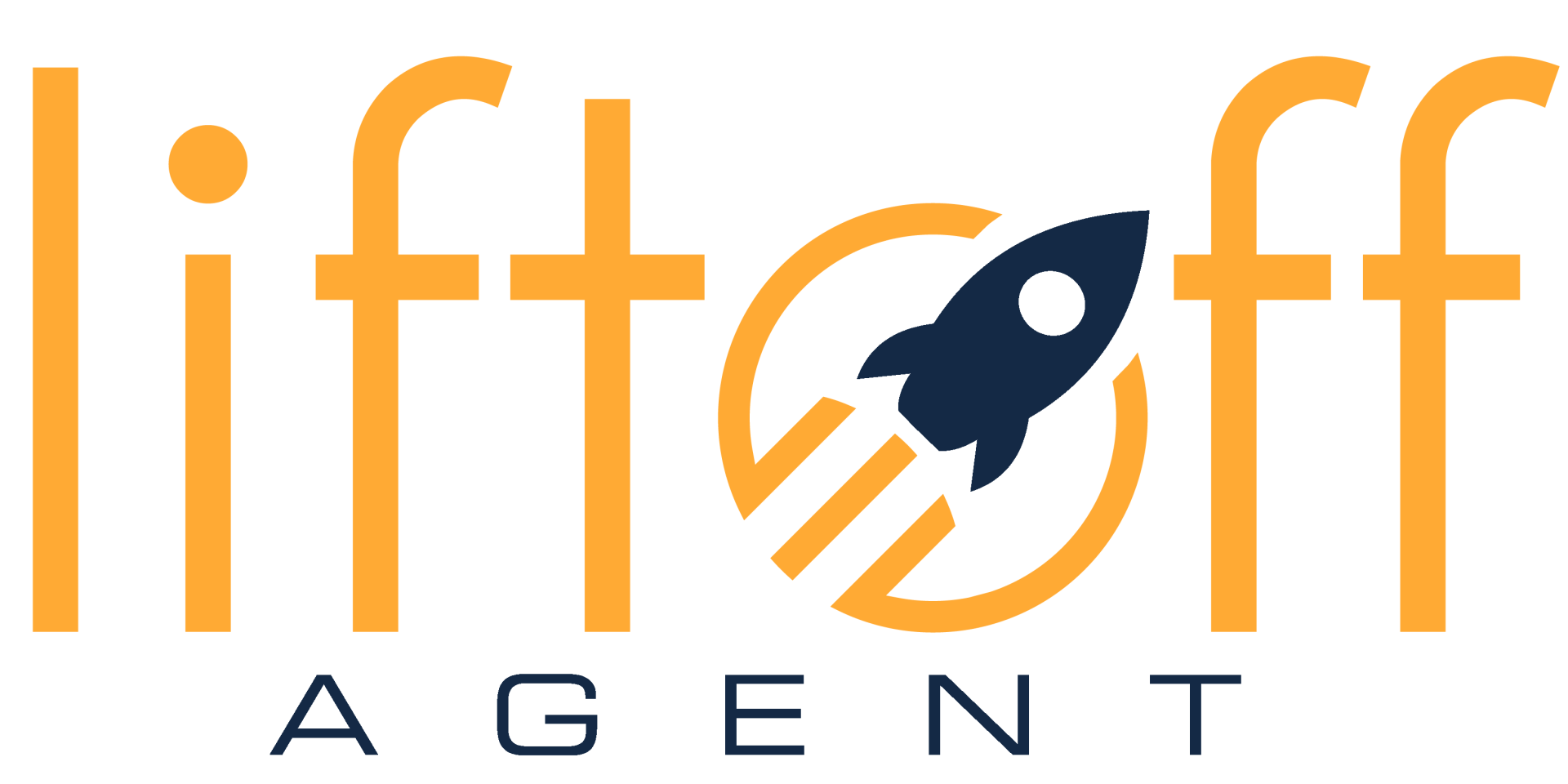
We specialize in working with real estate agents and teams to build local authority. We do this through creating and managing your brand, website, video and social presence.
We'd love to chat and show you how you can dominate your local market and avoid wasted marketing dollars.
Subscribe to Newsletter
Newsletter
We will get back to you as soon as possible.
Please try again later.

All Rights Reserved | Liftoff Agent